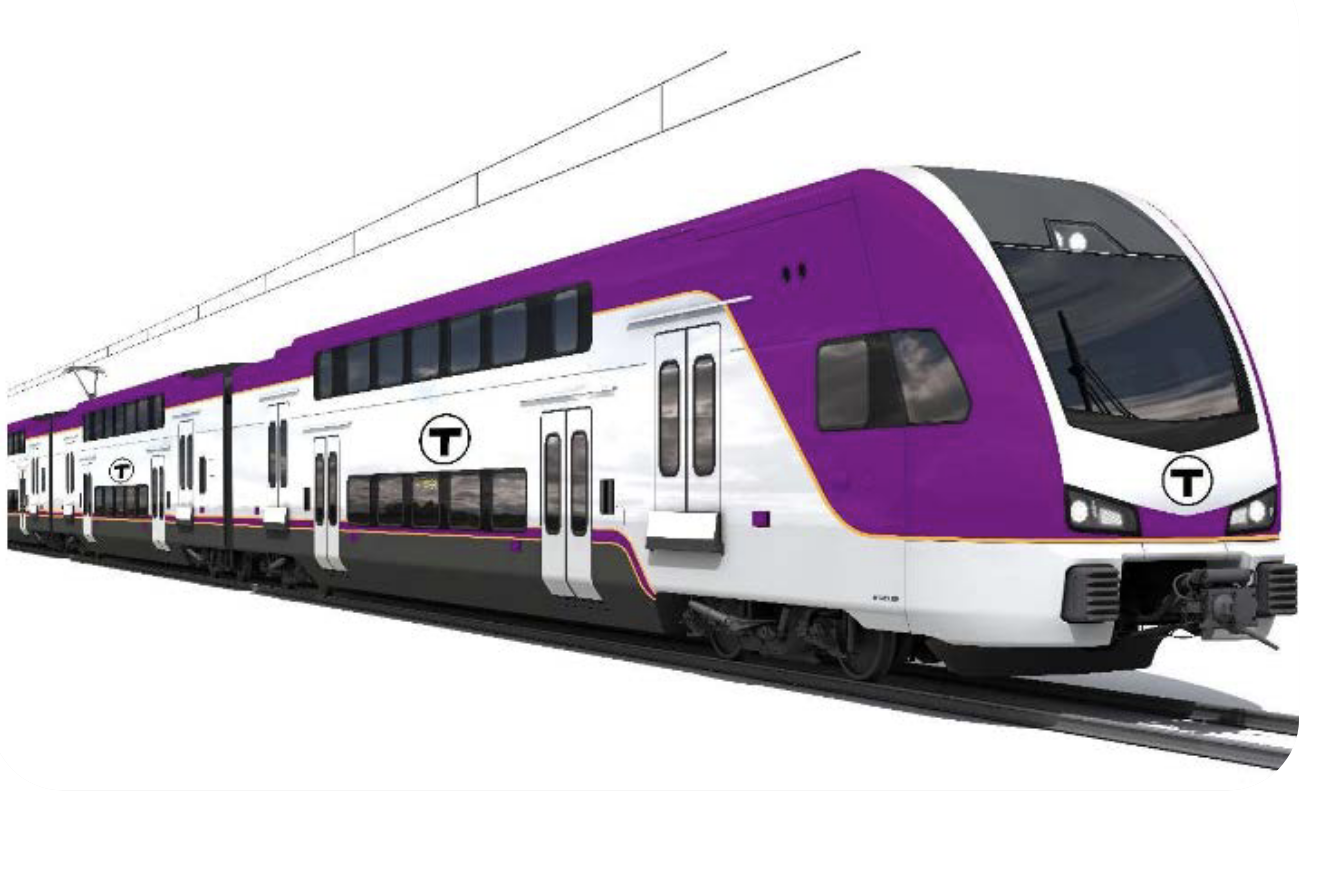At an MBTA board meeting last month, Head of Rail Transformation, Alistair Sawers, shared a proposal for “discontinuous electrification” - a concept that could electrify the T’s regional rail system faster, with lower infrastructure costs, by relying on battery-equipped electric trains.
Advocates are wary because the technology has not yet been adopted anywhere in the U.S., but Sawers anticipates we won’t be the first to try it. He told the MBTA board that several other peer agencies are also investing in similar technology.
“Because of the way battery technology has evolved so rapidly… you could take an existing bus battery and run a full train set from Boston to Newburyport on one charge,” said Sawers.
The T’s proposed hybrid approach to electrification would use a mix of overhead wires and batteries, instead of solely using overhead wires (catenary) for power, as originally envisioned by the T's Rail Vision plan.
Using batteries aboard trains could help the T avoid costly construction of overhead wires in places where they may be difficult to install and maintain, such as near bridges and tunnels.
Sawers highlighted that although the original idea for electrification under Rail Vision called for catenary power on all lines, this hybrid model would help speed things up, since less time would be eaten up by things like lengthy environmental approvals, planning, and review processes.
If approved, the hybrid model could be in service closer to 2030, which Sawers says gives us “the benefit of international experience and existing pieces of rolling stock.” Full decarbonization of the regional rail system under the hybrid model could happen by 2050, as opposed to 2063 if overhead wires were required for all rail lines.
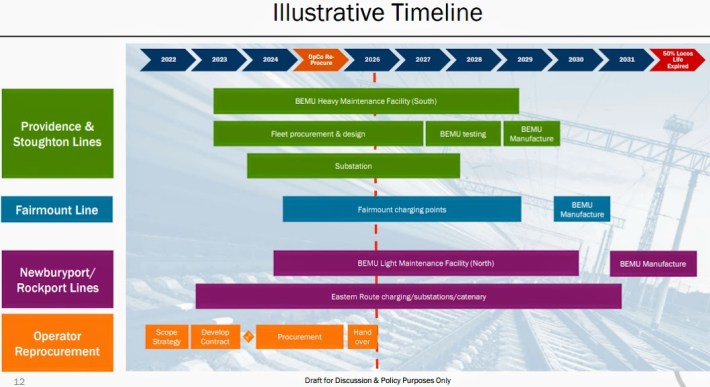
Earlier this year, the MBTA commissioned an analysis of the “discontinuous electrification” concept from Network Rail, the national public rail agency for Great Britain.
Network Rail's analysis focused on the highest-ridership segments of the regional rail network: the Providence, Stoughton, Fairmount, and Newburyport/Rockport lines (collectively identified as “phase 1” of the Rail Vision plan), plus a “Phase 1a” for the Worcester line.
Phase 1: Providence Line
The Providence Line runs from South Station and extends to Wickford Junction in Rhode Island.
The service goal for this line is to offer trains every 30 minutes from South Station to Stoughton and Providence, and every 60 minutes to Wickford Junction. During off-peak hours, service on the Stoughton branch would run every 60 minutes.
An advantage of this line is that it is already fully wired with overhead catenary service (OCS) for Amtrak's electric Northeast Corridor trains, which means that there are relatively few infrastructure upgrades needed to run additional electric trains for the T.
Changes to this line would include a potential new substation at Roxbury to support additional trains, as well as a new electrical maintenance facility at the Readville yard built on existing MBTA property in the Hyde Park neighborhood, an environmental justice (EJ) community on the Fairmount Line.
EJ communities tend to be the go to places for noisy or polluting industrial facilities, but “electric maintenance facilities are very different - they're very quiet typically,” said Sawers.
Phase 1: Stoughton Branch
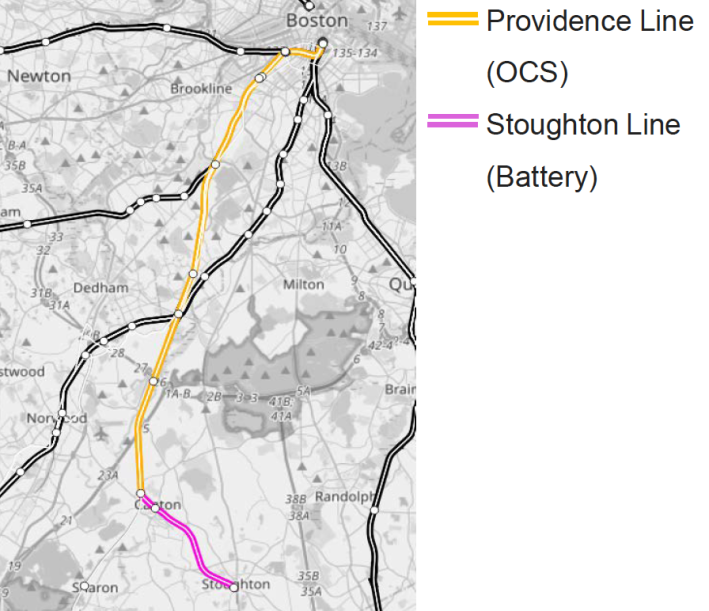
Despite no structural clearance issues identified for this branch of the Providence Line, the T believes that it could run electric trains on this branch without building any new overhead wires, with the stretch from South Station to Canton Junction running on the Providence Line’s existing overhead catenary wires, and the branch from Canton Junction to Stoughton running on batteries.
Phase 1: Fairmount Line
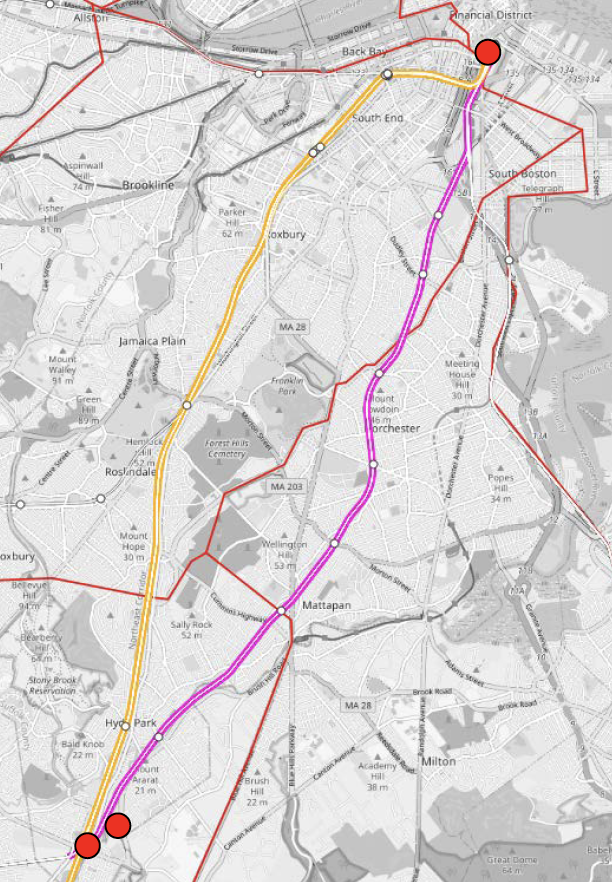
The Fairmount Line runs from South Station to Readville along several Environmental Justice communities in Boston including Dorchester, Mattapan and Hyde Park. In 2020 this line was part of an MBTA pilot project, made permanent earlier this spring, that increased frequency (trains every 45 minutes) and streamlined the payment process through the installation of CharlieCard fare validators at all eight Zone 1A stations on this line.
Under the rail electrification plan, the goal for the Fairmount line is to run all-day service every 15 minutes.
Even though the two clearance issues that were identified by the T’s consultants are both relatively near each other in Dorchester, the T's discontinuous electrification proposal calls for the Fairmount Line, which is relatively short, to run mainly on battery power.
The batteries would be charged via a short 1.5-mile stretch of catenary near South Station, and at a proposed new charging facility in Readville.
Using mainly batteries for this line, as opposed to installing overhead wire, is expected to save approximately $70 - $160 million.
Phase 1: Newburyport/Rockport lines
Otherwise known as the Environmental Justice (EJ) Corridor, the Newburyport Line and the Rockport Line includes several EJ communities including Lynn and Chelsea. As of last winter, Chelsea is home to a brand new, fully accessible Commuter Rail station with boarding platforms, ramps and easy access to the Silver Line.
The T’s electrification analysis identified numerous clearance issues ranging from low to high complexity along the line, including the Salem Tunnel.
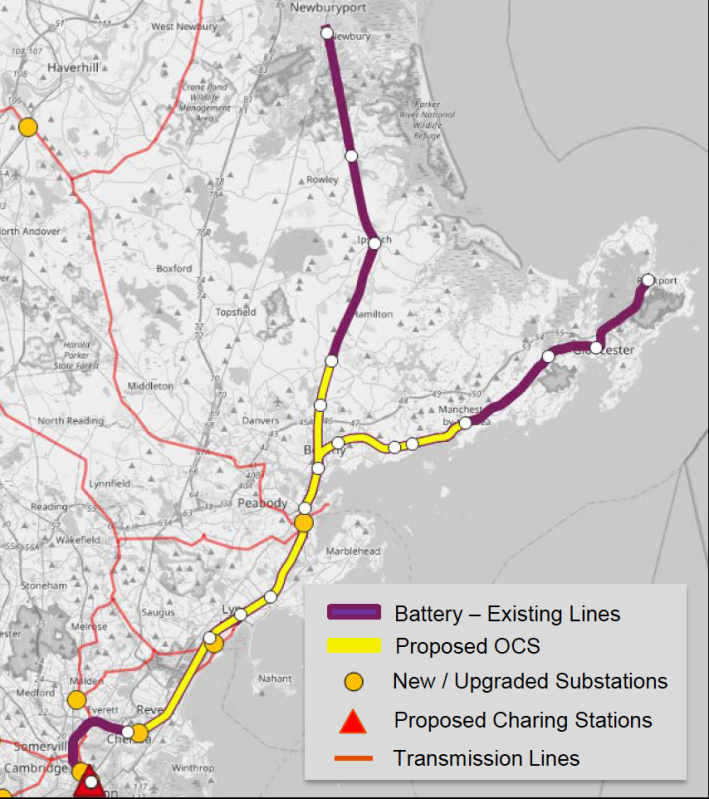
Sawers told the MBTA board that while it’s possible to add wire inside tunnels, it’s expensive. He added that five drawbridges along these lines would be a challenge for overhead wire due to how “difficult and expensive they are to retrofit and maintain with OCS.”
Another infrastructure obstacle Sawers pointed to is the limited capacity of the electrical grid in more rural parts of the state, such as Rockport, and the accommodations the T already has to make.
“We have to run diesel generators in the summer to provide backup power because the grid is so overtaxed with consumer demand and the actual main power grid feed out there is not sufficient,” said Sawers.
But the “discontinuous electrification” plan could solve those issues, and save about $200 million over 30 years, according to Network Rail.
Instead of building new overhead wires along the entire route, wires would be installed from Chelsea to just north of Beverly. Those wires would charge on-board batteries, which would then power trains for the rest of the route.
Batteries could also be charged at North Station and at a new electrified light maintenance facility, possibly in South Salem, where there is already a historic yard.
Phase 1a: Worcester Line
The proposal for this line includes battery-powered service on either end of the line, with overhead wires powering the middle portion.

Despite the cost savings anticipated by going the hybrid route, some transit advocates have reservations about opting away from a fully wired system, and would like to learn more about how the T’s proposal would meet the levels of frequency a regional rail system in the Boston area calls for.
Jarred Johnson, Executive Director of TransitMatters, is excited to see signs that the T is beginning to take rail electrification more seriously.
“I think there's an interesting debate to be had about the technology, but I think the thing that we’re really concerned about is making sure that the T moves forward with a proposal that works and that is able to provide the frequency and travel time that's really needed to make regional rail successful,” said Johnson.
He added, “We really have some concerns about the use of the battery technology in a way that’s just simply not being used anywhere else in the world for trains coming this frequently. We’re interested in learning a lot more, and hoping that the rail transformation team is starting a dialogue with advocates, with elected officials and stakeholders about how regional rail and how rail transformation develops.”
Sawers shared this model is currently in revenue service in three countries including Japan, where it has been in service for seven years now. Service on the Japanese lines runs through rural parts of the country, and with less frequency than what the T is proposing.
The MBTA has reached out to five train manufacturers, and Sawers told the MBTA board that more details will be disclosed in the near future.
Download a slide deck on the MBTA's "discontinuous electrification" concept from Network Rail.
